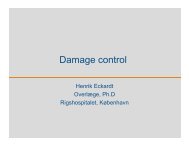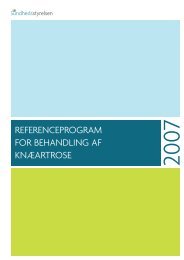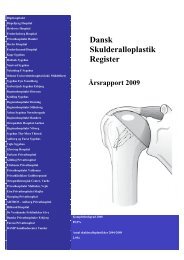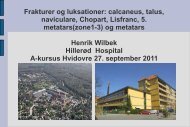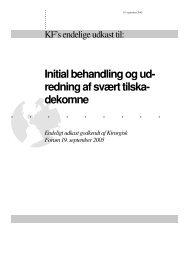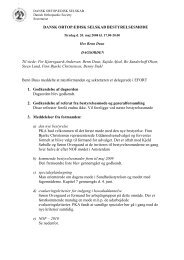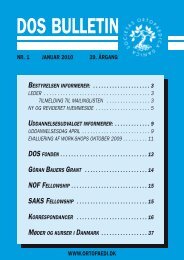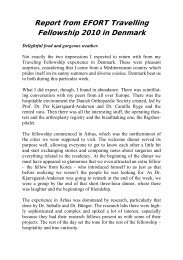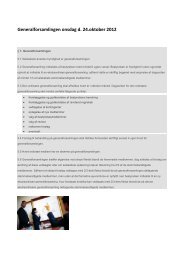DOS BULLETIN - Dansk Ortopædisk Selskab
DOS BULLETIN - Dansk Ortopædisk Selskab
DOS BULLETIN - Dansk Ortopædisk Selskab
You also want an ePaper? Increase the reach of your titles
YUMPU automatically turns print PDFs into web optimized ePapers that Google loves.
2010-378_<strong>DOS</strong> nr. 3 2010 29/09/10 10:08 Side 125<br />
Bioreactor activated graft material for early implant<br />
fixation in bone<br />
Susan Snoek Henriksen, Ming Ding, Søren Overgaard<br />
Orthopaedic Research Unit, Dept. of Orthopaedic Surgery and<br />
Traumatology, Odense University Hospital<br />
Background: Combined incubation of a composite scaffold with bone<br />
marrow stromal cells in a perfusion bioreactor, could make up a novel<br />
hybrid graft material with optimal properties for early fixation of bone<br />
to implant.<br />
Purpose: The aim of this study was to create a bioreactor activated graft<br />
(BAG) material, which can induce early fixation of bone to implant, similar<br />
to that of allograft.<br />
Methods: Mononuclear cells were isolated from the bone marrow of 8<br />
female sheep, and injected into a perfusion bioreactor with poly-lactic<br />
acid (PLA 12%) coated scaffold granules (HA/â-TCP). Hybrid material<br />
was incubated in the bioreactor for 2 weeks. Porous titanium alloy<br />
implants (diameter=length=10mm) were inserted bilaterally in each of<br />
the distal femurs of the sheep; thus 4 implants in each sheep. The concentric<br />
gap (2 mm) surrounding the implant was filled with 1) BAG<br />
(autogenous), 2) granules, 3) granules+bone marrow aspirate (BMA,<br />
autologous) or 4) allograft. The sheep were euthanized after 6 weeks.<br />
Push-out tests were performed to assess implant fixation.<br />
Findings: Results were assessed by One-way ANOVA. P-values less<br />
than 0.05 were considered significant. No significant differences regarding<br />
failure energy (kJ/m2, p=0.070) could be seen between the groups.<br />
Shear stiffness (MPa) was significantly higher for the allograft group,<br />
p=0.002. The BAG showed up to 1.5 and 2.4 folds better properties<br />
regarding shear stiffness than the granules alone or the granules+BMA<br />
respectively. The BAG also had up to 1.8 and 5.3 fold higher failure energy<br />
than the granules alone or the granules+BMA respectively.<br />
Conclusion: The present study is the first to show an effect of bioreactor<br />
activated bone substitute on mechanical fixation. However the<br />
mechanical fixation did not reach that of allograft. Probably, an extended<br />
observation time could increase the mechanical fixation of implants<br />
treated with the bioreactor activated graft.<br />
125



